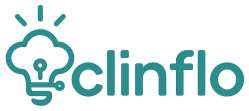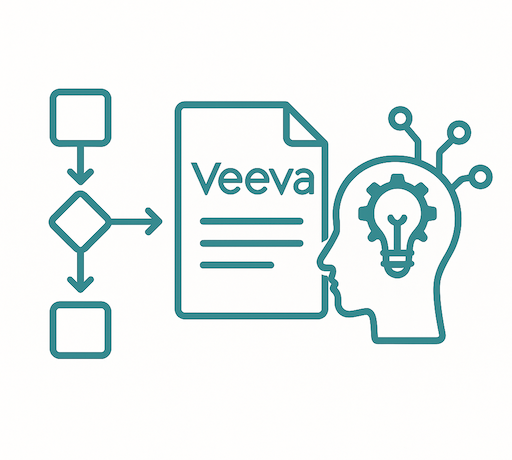Following the recent announcement from Veeva of their pending release of product support for AI/LLM, this article describes potential approaches for the application of AI in the form of agentics.
What is Agentic AI
Often called AI agents, Agentic AI is the application of AI to make decisions and take actions with a degree of autonomy, without requiring constant human guidance. Typically these systems use knowledge (data & meta data) to drive specific use cases within an organisation.
Potential application areas for Agentic AI in Veeva Vault CTMS
1. Study Start-Up Automation
- Site identification and feasibility analysis using historical data and real-time metrics.
- Pre-populating regulatory document packages for each site.
- Detecting bottlenecks in start-up processes and recommending interventions.
2. Milestone Tracking & Escalation
- Monitoring study milestones and autonomously:
- Notifying relevant parties.
- Escalating issues when thresholds are breached.
- Recommending corrective actions based on previous similar trials.
3. Site Monitoring Planning
- Proactively generating monitoring visit schedules based on site performance and risk profiles.
- Adjusting visit plans based on real-time deviation or enrollment data.
4. Risk-Based Monitoring (RBM)
- Analysing site data to identify risk signals and automatically:
- Recommend focused monitoring.
- Suggest preventive actions before formal triggers occur.
5. Investigator Performance Evaluation
- Continuously reviewing investigator activity (e.g., data timeliness, protocol deviations).
- Recommending replacement or intervention with underperforming sites.
6. Query Management
- Analysing query trends to:
- Identify systemic problems (e.g., poorly designed forms).
- Suggest wording for improved future query templates.
7. Workflow and Task Management
- Dynamically assigning or re-assigning tasks based on team availability, workload, and deadlines.
- Suggesting task bundling or sequencing improvements.
8. Communication Optimisation
- Drafting updates or reminders to sites and study teams.
- Proactively scheduling coordination calls or resolving simple queries autonomously.
9. Reporting and Insights Generation
- Proactively identifying unusual patterns in enrollment, dropout rates, or data entry delays.
- Summarising key risks and trends for weekly CTMS reports or executive dashboards.
10. Regulatory Compliance Checks
- Scanning documentation for missing or expiring items.
- Notifying teams and generating draft compliance summaries for auditors.
11. Protocol Amendment Impact Analysis
- Assessing how a protocol amendment affects ongoing operational plans.
- Recommending revised resource allocations or timeline adjustments.
12. Cross-Study Learning
- Identifying learnings from past studies and recommending process improvements in ongoing trials.
Supplementing data to support agentics
The above list of ‘CTMS’ based agentics will not work without additional data. To some extent it makes sense to base the management of agents from the Trial Management function as in principle it has general oversight of the study. Query escalation as an example might belong in EDC/CDB, however, the context that might support such an operate might come from trial management information.
Here is a list of potential additional data sources that would be required to drive agentics for the above use cases;
| Agentic Function | Data Augmentation Needed | External Data Sources |
|---|---|---|
| Site selection | Historical performance | Legacy CTMS, public registries, CRO shared data |
| RBM | Inspection history, geo-risk | QA systems, regulatory bodies |
| Milestone prediction | Historical timelines | PM tools, IRB portals |
| Investigator scoring | Prior performance | Public registries, CRM, CROs |
| Amendment impact | Resources, timelines | R&D ops, budget tools |
| Enrollment forecasting | Demographics, epidemiology | IQVIA, health databases |
| Compliance | Regs, training | QMS, regulatory intel |
| Cost/resource planning | Budgets, contracts | Financial systems |
How might a data retrieval and augmentation system work?
Retrieval-augmented generation (RAG) is the means of storing ‘data’ used to support AI Large Language Models. These are defined in what are referred to as Vector databases.
A RAG architecture enhances LLMs by allowing them to retrieve contextually relevant information from structured and unstructured data at query time, rather than relying solely on what’s in the model’s training data. In Veeva CTMS, RAG could act as the knowledge driving a “thinking assistant” that:
- Understands what information is missing from Vault CTMS,
- Fetches it from approved external sources (indexed or API-based), and
- Synthesises insights or decisions for CTMS workflows (like site scoring or milestone prediction).
The role of Veeva’s Direct Data API
Veeva recently announced the availability of their high speed data / metadata API for no additional license fee. This was in response to some objections from Veeva clients that the fee’s restricted their use of their data. This information is an ideal source for RAG population supplemented by data sourced from other systems.
Who will built these RAG knowledge bases?
This is happening today, primarily within large BioPharm companies. It requires skills and compute power. It also demands quality and management controls. It can be difficult to measure the accuracy and quality of data and therefore the corresponding quality of agentics decision making.
Discover more from ClinFlo Consulting
Subscribe to get the latest posts sent to your email.

